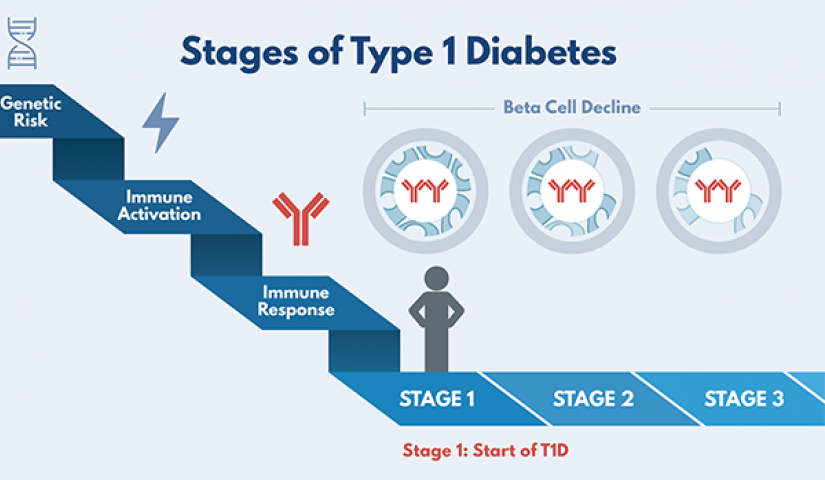
Type 1 diabetes staging classification opens door for intervention
For most people, the onset of type 1 diabetes seems to occur suddenly, often resulting in a trip to the emergency room with life-threatening complications such as diabetic ketoacidosis (DKA). TrialNet is working to change that scenario.
In Diabetes Care, the JDRF, American Diabetes Association (ADA), and Endocrine Society recommended adoption of a new type 1 diabetes staging classification.
This recommendation is largely based on two decades of TrialNet research involving more than 160,000 relatives of people with type 1 diabetes.
Type 1 diabetes can now be most accurately understood as a disease that progresses in three distinct stages.
STAGE 1 is the start of type 1 diabetes. Individuals test positive for two or more diabetes-related autoantibodies. The immune system has already begun attacking the insulin-producing beta cells, although there are no symptoms and blood sugar remains normal. Learn more ›
STAGE 2, like stage 1, includes individuals who have two or more diabetes-related autoantibodies, but now, blood sugar levels have become abnormal due to increasing loss of beta cells. There are still no symptoms. Learn more ›
For both stages 1 and 2, lifetime risk of developing type 1 diabetes approaches 100 percent.
STAGE 3 is when clinical diagnosis typically takes place. By this time, there is significant beta cell loss and individuals generally show common symptoms of type 1 diabetes, which include frequent urination, excessive thirst, weight loss, and fatigue. Learn more ›
The new staging classification is vital to understanding how type 1 progresses. Equally important is TrialNet's ability to diagnose the disease in its earliest stages, allowing for prompt intervention.
According to TrialNet Chair Carla Greenbaum, MD, "Identification of the pre-symptomatic stages of type 1 diabetes can be compared to identification of high blood pressure as a predictor of heart attack and stroke. Before treatment for high blood pressure became commonplace, we were missing a key tool to prevent heart disease. Today, people can receive intervention long before they experience symptoms or significant complications."
Clinical research supports the usefulness of diagnosing type 1 diabetes early–before beta cell loss advances to stage 3. The earlier diagnosis is made in the disease process, the sooner intervention can take place, and the more beta cells are likely to remain. More beta cells may lead to better outcomes regarding blood sugar control and reduction of long-term complications.
"TrialNet's goal is to identify the disease at its earliest stage, delay progression, and ultimately prevent it. We offer screening and clinical trials for every stage of type 1 diabetes and close monitoring for disease progression," explains Dr. Greenbaum.
For people who participate in type 1 diabetes prevention research like TrialNet, the risk of DKA at diagnosis decreases from 30 percent to less than 4 percent.
Both the ADA and JDRF recommend TrialNet screening for people who have relatives with type 1 diabetes. Family members have a 15 times greater risk of being diagnosed than someone with no family history. Screening is available at no charge to:
- Anyone between the ages of 2.5 and 45 with a sibling, child or parent with type 1 diabetes.
- Anyone between the ages of 2.5 and 20 with a sibling, child, parent, cousin, uncle, aunt, niece, nephew, grandparent, or half-sibling with type 1 diabetes.
It is recommended that children who do not test positive for diabetes-related autoantibodies continue to get rescreened every year until age 18.
There are more than 200 TrialNet screening sites worldwide. Screening test kits are also available by mail. Learn more at trialnet.org.




